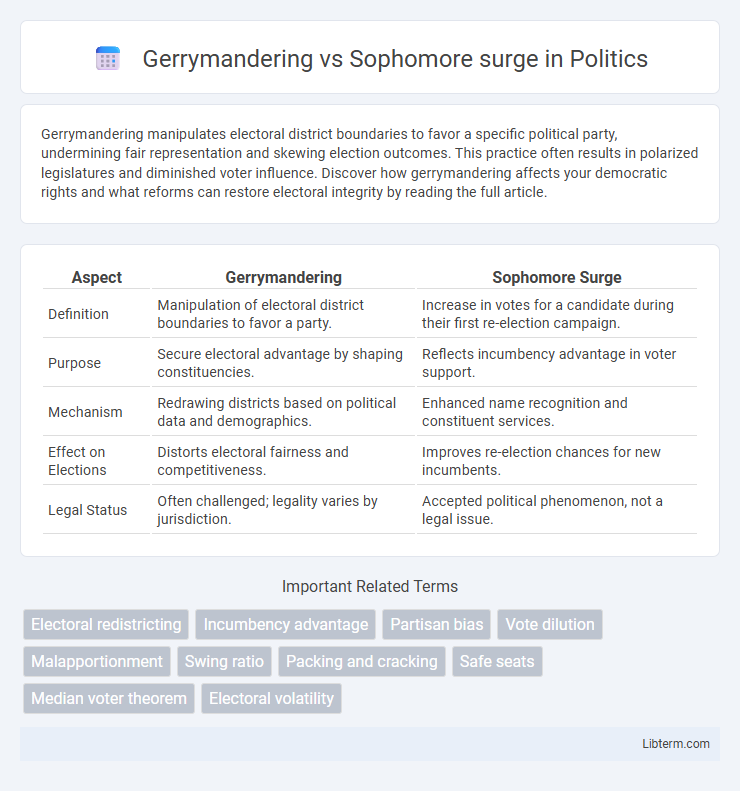Gerrymandering manipulates electoral district boundaries to favor a specific political party, undermining fair representation and skewing election outcomes. This practice often results in polarized legislatures and diminished voter influence. Discover how gerrymandering affects your democratic rights and what reforms can restore electoral integrity by reading the full article.
Table of Comparison
| Aspect | Gerrymandering | Sophomore Surge |
|---|---|---|
| Definition | Manipulation of electoral district boundaries to favor a party. | Increase in votes for a candidate during their first re-election campaign. |
| Purpose | Secure electoral advantage by shaping constituencies. | Reflects incumbency advantage in voter support. |
| Mechanism | Redrawing districts based on political data and demographics. | Enhanced name recognition and constituent services. |
| Effect on Elections | Distorts electoral fairness and competitiveness. | Improves re-election chances for new incumbents. |
| Legal Status | Often challenged; legality varies by jurisdiction. | Accepted political phenomenon, not a legal issue. |
Introduction to Gerrymandering and Sophomore Surge
Gerrymandering refers to the manipulation of electoral district boundaries to favor a particular political party, often resulting in distorted representation and reduced electoral competition. The sophomore surge describes the increase in votes that first-term incumbents typically experience during their first reelection campaign, fueled by heightened name recognition and constituent services. Both concepts critically impact electoral dynamics, influencing the fairness and outcomes of legislative elections.
Historical Context of Gerrymandering
Gerrymandering originated in 1812 when Massachusetts Governor Elbridge Gerry approved a redistricting plan favoring his party, giving rise to the term by combining his name with "salamander" due to the distorted district shapes. Historically, this manipulation of electoral boundaries has been used to concentrate or dilute voting power, influencing legislative outcomes and undermining democratic representation. The Sophomore surge, contrastingly, refers to the increased vote share that first-term incumbents often experience in elections, emerging as voters respond to the performance and visibility of new representatives rather than redistricting tactics like gerrymandering.
Understanding the Sophomore Surge Phenomenon
The Sophomore Surge phenomenon describes the notable increase in votes that congressional candidates often experience when running for re-election for the first time, typically ranging from 5% to 10%. This surge reflects the advantages of incumbency, such as increased name recognition, established constituent services, and greater campaign resources. Unlike gerrymandering, which manipulates district boundaries to favor a party, the Sophomore Surge is a natural electoral boost derived from a candidate's growing political presence and voter familiarity.
Mechanisms and Techniques of Gerrymandering
Gerrymandering manipulates electoral district boundaries through techniques such as "cracking," which dilutes opposition votes by spreading them thinly across districts, and "packing," which concentrates opposition voters into a few districts to reduce their overall influence. These mechanisms contrast with the sophomore surge, an increase in votes received by first-term incumbents due to name recognition and constituent services, which is a natural electoral advantage rather than a structural manipulation. Gerrymandering strategically alters district composition to predetermine electoral outcomes, whereas the sophomore surge results from voter behavior and incumbency benefits.
Factors Influencing the Sophomore Surge
Factors influencing the sophomore surge include incumbency advantages such as increased name recognition, established constituent services, and improved campaign funding. Electoral dynamics like district partisanship and voter turnout fluctuations also play significant roles in enhancing vote share for first-term candidates seeking re-election. Strategic efforts by candidates to leverage media exposure and local endorsements further contribute to the magnitude of the sophomore surge.
Impact of Gerrymandering on Election Outcomes
Gerrymandering significantly distorts election outcomes by manipulating district boundaries to favor a particular party, often resulting in disproportionate representation that undermines voter equality. This practice diminishes the potential impact of the sophomore surge, where newly elected incumbents typically experience increased vote shares due to heightened visibility and constituent services. Consequently, gerrymandering entrenches partisan advantage, reduces electoral competitiveness, and weakens the natural advantage that sophomore candidates might otherwise leverage.
Sophomore Surge: Effects on Political Careers
Sophomore surge refers to the significant increase in votes that first-term incumbents often experience during their initial re-election campaigns, demonstrating their growing name recognition and constituent support. This phenomenon boosts political careers by strengthening incumbents' positions, deterring potential challengers, and increasing their influence within legislative bodies. Unlike gerrymandering, which manipulates district boundaries to favor specific parties, sophomore surge reflects genuine voter approval and can lead to longer, more stable political tenures.
Comparing Voter Behavior in Gerrymandered vs. Non-Gerrymandered Districts
Voter behavior in gerrymandered districts often shows reduced electoral competition, leading to lower voter turnout and increased incumbent advantage, while non-gerrymandered districts tend to exhibit higher electoral competitiveness and more dynamic voter engagement. The sophomore surge, a phenomenon where newly elected incumbents experience a significant vote share increase in their first re-election, is typically muted in gerrymandered districts due to predictable partisan boundaries. Studies reveal that voter responsiveness and turnout are more robust in competitive, non-gerrymandered districts, highlighting the impact of district design on democratic participation.
Policy Implications and Reform Proposals
Gerrymandering distorts electoral representation by manipulating district boundaries, undermining democratic fairness and prompting calls for independent redistricting commissions to ensure impartial maps. The sophomore surge, characterized by increased incumbent vote share in a second election, highlights the advantage of existing officeholders and has led to proposals for term limits to promote political competition. Policy reforms targeting both issues aim to enhance electoral integrity, balance voter influence, and foster a more equitable political landscape.
Conclusion: Future of Electoral Strategies
Gerrymandering continues to shape electoral outcomes by manipulating district boundaries to favor specific parties, while the Sophomore surge highlights the advantage incumbents gain in their first re-election bid through increased visibility and constituent services. Advances in data analytics and micro-targeting are expected to refine these strategies, enabling more precise voter influence and district optimization. The future of electoral strategies will likely involve a complex interplay of legal reforms, technological innovation, and behavioral insights to balance competitive fairness with strategic campaigning.
Gerrymandering Infographic

 libterm.com
libterm.com